1. Introduction
The Luminescence Dating Laboratory makes the luminescence dating method available to the archaeological/geomorphological/ geological/art-historical communities. This method evaluates the time since crystalline minerals were exposed to light or heat: examples are of mineral grains of sand from sediment or a ceramic piece, and microcrystalline phases in an archaeological artifact manufactured from flint.
Luminescence dating is based on a combination of retrospective dosimetry and environmental dosimetry. The normal age range for dating is between 50 years and 100 thousand years. However, depending on the dosimetric properties of the signal and material being analysed, and the radioactivity of its environment, this method is able to date exposition to sunlight or firing between 0 years and >1 million years. The materials analysed for dating are inorganic and are highly resistant to alteration during their burial. Luminescence dating is therefore optimized for studies of the chronologies of human development and environmental records during the Holocene and late Quaternary. In addition to dating per se, the Luminescence Dating Laboratory has interests in the development of new methodologies and applications related with dating; retrospective dosimetry; environmental dosimetry and radiogeochemistry; and investigation of the origins and physical processes of luminescence in minerals.
The work of the Luminescence Dating Laboratory is conducted through a combination of research projects, supervision of masters and doctoral theses, and service work to private and public entities related with cultural heritage and geosciences. If you are interested in developing a project, or in the dating or other luminescence analysis of a site or group of samples, please contact us as early as possible so that we can help to optimise sampling strategy and design of the work program to address the questions that you intend to investigate. For service work, just as in research projects, following consultation we will normally aim to perform the sampling ourselves, accompanied by the client/colleague. In this way we have the best chance of maximizing the information obtained per sample analysed.
2. Available Equipment
2.1. Sampling and Sample Preparation
- Tubes for sampling sediments in stainless steel and plastic c. 10 ml to c. 1 l.
- Diamond saw, hollow diamond drills and tungsten drills, water cooled, for subsampling pieces and stones.
- Hydraulic press for disaggregation.
- Range of calibrated sieves (63 mm - 2 mm) for grain-size separation (< 90 mm settled in water or acetone).
- Centrifuge (4x500ml or 8x50ml), temperature controlled and ventilated with filtering of gasses.
- HF rated fume cupboard, ventilated with filtering of gasses.
- Heavy liquid (LST Fastfloat) for density separation to c. 3 g/cm3.
- Range of strong acids for dissolution of mineral phases (ex. HCl, HF, Fluorosilicic).
- Stainless steel and aluminium disks, 1 cm diameter and for single grains, for presentation of prepared fractions for luminescence measurement.
- Ovens for thermal treatments to 1200°C.
- High precision balance.
- Binocular microscope.
- Mineralogical analyses are made using XRD by the GeoLuC group, using communal facilities of the UCQR.
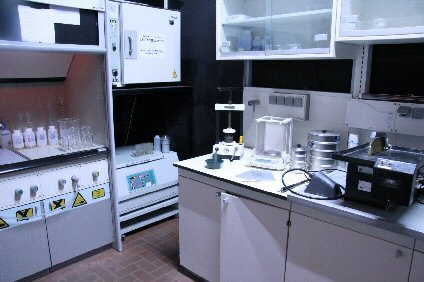
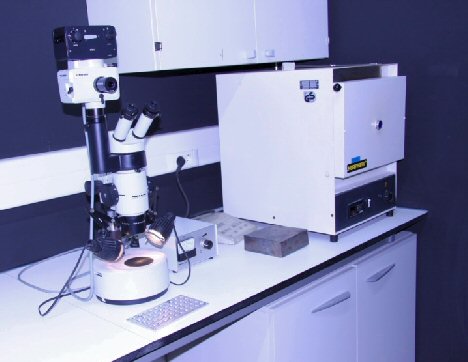
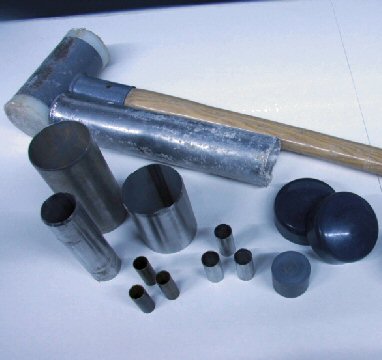
2.2. Luminescence Analysis
- Risø DA-20 automatic reader with Beta irradiator, 90Sr/90Y plaque (40mCi@2007) in
calibrated geometry, and photomultiplier for detection between 160 and 630 nm:
-> aliquots measured by TL, and OSL stimulated with LEDs (c. 470 nm, c. 875 nm);
-> single grains measured by OSL stimulated by laser/laser diode (532 nm, 830 nm); - Risø DA-15 automatic reader with Beta irradiator,
90Sr/90Y plaque (40mCi@2000) in calibrated geometry, and photomultiplier for detection
between 160 and 630 nm:
-> aliquots measured by TL, and OSL stimulated with LEDs (c. 470 nm), laser diode (830 nm), or halogen lamp (380 – 1020 nm). - Daybreak Beta irradiator, 90Sr/90Y plaque (40mCi@2000) in calibrated geometry.
- Littlemore Alpha irradiator with vacuum system, 241Am foils (total 182mCi@2001) in calibrated geometry.
- Range of glass filters for choice of detection band (or stimulation band from halogen lamp).
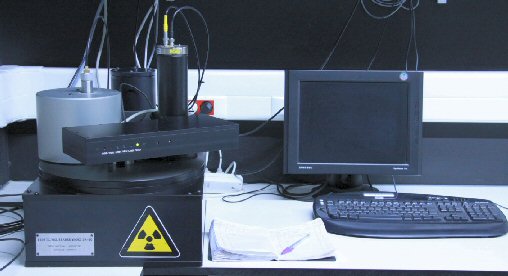
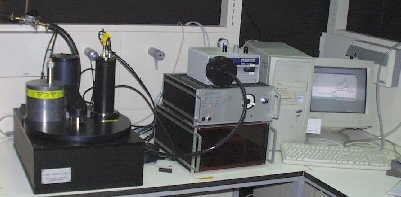
Risø Automatc Reader DA-20.
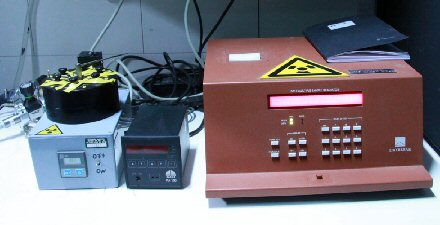
Irradiador Daybreak Beta.
2.3. Dosimetric Analysis
- In situ gamma spectrometry with calibration for sediment dosimetry based on measurements in the "Oxford
blocks":
-> Target Nanospec MCA with NaI probe, 2"x2";
-> 2 x HPI Rainbow MCA with NaI probes, 1"x1", 2"x2" e 3"x3". - In situ gamma dosimetry by thermoluminescence -> Dosimeters of Al2O3:C (TLD500) in quartz housings.
- Evaluation of K, Th and U concentrations for samples in the laboratory is made by the Laboratory for Instrumental Neutron Activation Analysis.
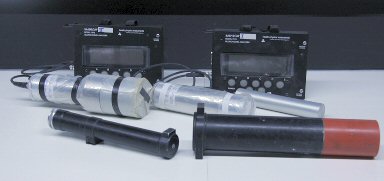
Oxfod Blocks.
Equipment financed by
Managing Authority and Funding
FCT – Fundação para a Ciência e a Tecnologia
Plano Nacional de Re-equipamento Científico
Project Reference: REEQ/590/CTE/2005
Further information: Phone (+351-21-9946222 – Dr. Isabel Dias) or e-mail: tl-osl@itn.pt.
